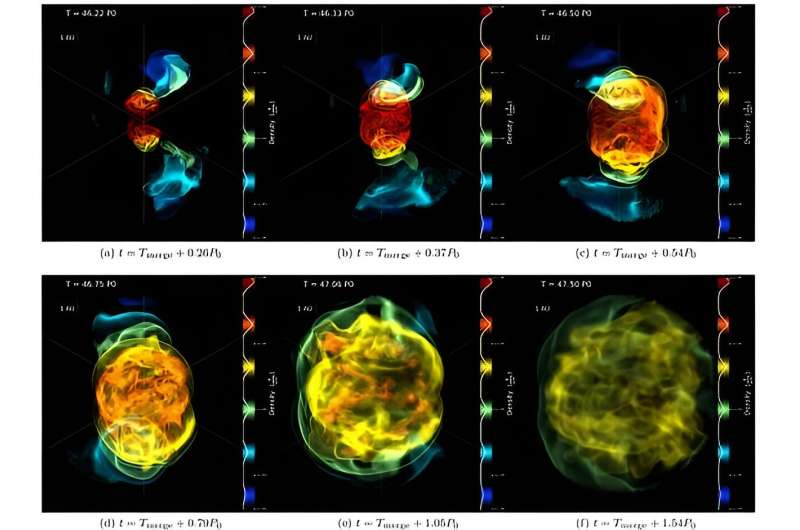This article has been reviewed according to Science X's editorial process and policies. Editors have highlighted the following attributes while ensuring the content's credibility:
fact-checked
preprint
trusted source
proofread
Did Betelgeuse consume a smaller star?

What's going on with Betelgeuse? In recent years it's generated a lot of headlines as its luminosity has shifted dramatically several times. The red supergiant brightened by almost 50% earlier this year, triggering speculation that it may go supernova.
But new research suggests there's something completely different happening with Betelgeuse that has nothing to do with its recent fluctuations. It may have consumed a smaller companion star.
Listen, when a star like Betelgeuse brightens and dims to such great extents, humans are bound to sit up and take notice. That's because it's a red supergiant and will certainly blow up as a supernovae. But there's no need to run out and get more tinfoil for our protective head gear. It's too far away to hurt us, but would be one heck of a light show.
Unfortunately for the spectacle-seeker inside all of us, none of the star's recent luminosity fluctuations mean its explosion and destruction are imminent. Instead, the changes have been attributed to dust clouds and the star's regular pulsations.
Some new research can't explain Betelgeuse's recent fluctuations, but it suggests something else happened with our supergiant neighbor in its past. The new study posted to the arXiv pre-print server is titled "Betelgeuse as a Merger of a Massive Star with a Companion." The lead author is Sagiv Shiber from the Department of Physics and Astronomy at Louisiana State University.
But did Betelgeuse have a companion?
"It has been firmly established that the majority of massive stars exist within binary systems," the authors write. Many of them will experience binary interactions at some point during their evolution. Sometimes, though rarely, the stars can merge. Is that why Betelgeuse is alone?
When a merger happens, a lot depends on the respective masses of the stars. There can be transient "merge-bursts," mass loss, as well as other phenomena.
This is all determined by simulations in the new research. The researchers simulated a merger between a 16 solar mass star and a smaller 4 solar mass star. (Betelgeuse is between 16 and 19 solar masses.) The simulations show that as the stars move closer together and share a common envelope, eventually the minor star merges with the primary star's helium core. "The companion eventually plunges into the envelope of the primary, leading to its spin-up and subsequent merger with the helium core," the authors explain. That causes an exchange of both orbital and thermal energy. Eventually, it triggers a powerful pulse that travels from the core through the primary star's envelope.
But it doesn't stop there. Sometimes, it can also trigger mass loss. That happens because of the release of gravitational energy caused by the merger. That energy has to express itself somehow, and it's converted into kinetic energy that drives high-speed mass flow away from the primary. In the team's simulations, the mass loss reached as high as 0.6 Earth masses.
But when it comes to Betelgeuse, the evidence for a merger sometime in the past may be in the star's rotation. It rotates at about 5.5 km/second. For reference, our sun rotates at about 2 km/second. "For instance, studies on Betelgeuse have demonstrated that a previous merger between a pre-main sequence massive star with a mass of approximately 15~17M Earth masses and a low-mass main sequence companion with a mass of around 1 ~ 4M Earth masses could account for its implied high rotation rate," the paper states.
The merger doesn't interrupt the primary star's evolution into its red super giant (RSG) phase. But it does eject material, often through polar outflows. The gas can travel as fast as 200–300 km/s, which is characteristic of mergeburst events.
There's precedent for this type of merger in V838 Monocerotis. It was a possible luminous red nova, a stellar explosion caused by the merger of two stars. It was unremarkable until 2002 when it suddenly brightened, and was one of the largest known stars for a period of time after the purported merger. A 2007 paper concluded that the mergeburst was the only explanation for V838 Monocerotis' brightening and expansion.
So is this what happened with Betelgeuse? Did it merge with and consume a smaller companion, leaving no trace? It's implied rotation rate supports that conclusion, as does the star's chemical composition.
This study can't reach that conclusion, but it's a distinct possibility. There's a lot astrophysicists don't yet know about these mergers and their effects. The size of the stars' envelopes and eventual common envelope affects the eventual spin-up rate of the surviving primary. And the amount of mass loss can dispel different amounts of kinetic energy, so there's a lot going on.
The authors made some progress in understanding these events, but they need improved methods and tools to understand them more completely.
"By delving deeper into the physics of stellar mergers, we aim to advance our understanding of massive star evolution, the properties of supernova progenitors, and the role of mergers in shaping the astrophysical transient landscape," they write.
There's no indication that this merger, if it occurred, is directly connected to Betelgeuse's recent fluctuations, or to its eventual explosion as a supernova. But one day, Betelgeuse will explode. If humanity lasts long enough, then many future generations of scientists will be fortunate enough to watch the whole process play out. Then we may finally have answers.
But for now, the red supergiant keeps generating headlines.
More information: Sagiv Shiber et al, Betelgeuse as a Merger of a Massive Star with a Companion, arXiv (2023). DOI: 10.48550/arxiv.2310.14603
Journal information: arXiv
Provided by Universe Today




















